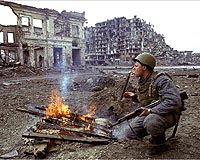| . |  |
. |
Ft Worth TX (SPX) Jul 29, 2009 A ceremony at Lockheed Martin's Fort Worth plant marked the rollout of the U.S. Navy's first-ever stealth fighter, the F-35C Lightning II. The aircraft will enable the Navy to possess 5th generation fighter capabilities at sea, extending America's reach and reducing the timeline from threat to response. Top Navy leadership, signal flags and a crowd of employees, including reserve and retired Navy personnel, were on hand to celebrate the strike fighter's unveiling. Adm. Gary Roughead, the U.S. Navy's Chief of Naval Operations, welcomed the new aircraft to the fleet. "The JSF will show the world that our Sailors will never be in a fair fight because this airplane will top anything that comes its way," Roughead said of the F-35. "It will give our Sailors and pilots the tactical and technical advantage in the skies, and it will relieve our aircraft as they age out." Tom Burbage, a former Navy test pilot and the executive vice president and general manager of F-35 Program Integration for Lockheed Martin, thanked Navy leadership for being fully engaged in the F-35's development and "actively working to define joint and coalition tactics that will exploit this platform in ways we've never envisioned. We at Lockheed Martin are both proud and humbled by the trust the U.S. Navy has placed with us to lead the development and introduction of the Navy's newest stealthy, supersonic strike fighter." The first F-35C, known as CF-1, will undergo a wide-ranging series of ground tests before its first flight, scheduled for late 2009. CF-1 is the ninth F-35 test aircraft to be rolled out, and joins a fleet of F-35A (conventional takeoff and landing) and F-35B (short takeoff/vertical landing) variants that have logged more than 100 flights. The F-35C is on schedule to meet the Navy's Initial Operational Capability in 2015, and represents a leap in technology and capability over existing fighters, combining stealth with supersonic speed and high agility. The Lightning II employs the most powerful and comprehensive sensor package ever incorporated into a fighter. The F-35C possesses uncompromised carrier suitability and low-maintenance stealth materials designed for long-term durability in the carrier environment. The Lightning II's operational and support costs are forecast to be lower than those of the fighters it will replace. The F-35 and F-22 are the world's only 5th generation fighters, uniquely characterized by a combination of advanced stealth with supersonic speed and high agility, sensor fusion, network-enabled capabilities and advanced sustainment. The F-35 is a supersonic, multi-role, 5th generation strike fighter. Three F-35 variants derived from a common design, developed together and using the same sustainment infrastructure worldwide, will replace at least 13 types of aircraft for 11 nations initially, making the Lightning II the most cost-effective fighter program in history. Lockheed Martin is developing the F-35 with its principal industrial partners, Northrop Grumman and BAE Systems. Two separate, interchangeable F-35 engines are under development: the Pratt and Whitney F135 and the GE Rolls-Royce Fighter Engine Team F136. Share This Article With Planet Earth
Related Links Lockheed Martin The latest in Military Technology for the 21st century at SpaceWar.com
 Outside View: Counterinsurgency challenges
Outside View: Counterinsurgency challengesWashington (UPI) Jul 28, 2009 The effective execution of full spectrum counterinsurgency operations remains a challenge for the U.S. military. U.S. Army doctrine states that successful COIN operations depend on the synchronized application of combat, security, political, economic, psychological and civic actions. To achieve unity of effort, these activities need to be coordinated across military services, government ... read more |
|
| The content herein, unless otherwise known to be public domain, are Copyright 1995-2009 - SpaceDaily. AFP and UPI Wire Stories are copyright Agence France-Presse and United Press International. ESA Portal Reports are copyright European Space Agency. All NASA sourced material is public domain. Additional copyrights may apply in whole or part to other bona fide parties. Advertising does not imply endorsement,agreement or approval of any opinions, statements or information provided by SpaceDaily on any Web page published or hosted by SpaceDaily. Privacy Statement |